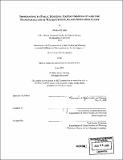| dc.contributor.advisor | Aixa Cintrón. | en_US |
| dc.contributor.author | Safai, Ahsha Ali, 1973- | en_US |
| dc.contributor.other | Massachusetts Institute of Technology. Dept. of Urban Studies and Planning. | en_US |
| dc.date.accessioned | 2012-03-16T16:01:00Z | |
| dc.date.available | 2012-03-16T16:01:00Z | |
| dc.date.copyright | 2000 | en_US |
| dc.date.issued | 2000 | en_US |
| dc.identifier.uri | http://hdl.handle.net/1721.1/69758 | |
| dc.description | Thesis (M.C.P.)--Massachusetts Institute of Technology, Dept. of Urban Studies and Planning, 2000. | en_US |
| dc.description | Includes bibliographical references (leaves 149-151). | en_US |
| dc.description.abstract | For centuries the United States has received waves of immigrants. In fact, many scholars would argue that America is a nation of immigrants. At the height of foreign migration to the US - late nineteenth, early twentieth century - many of America's Northeast cities became gateways or ports-of-entry for generations of immigrants. Upon arrival in these gateway cities, most immigrants, but particularly low-income immigrants, could rely upon the existence of the port-of-entry neighborhood - a neighborhood in which the affordability of the housing stock afforded recent migrants the opportunity to live in close proximity to someone with whom they shared a common culture, experience, and language. After World War II, however, the US rapidly expanded, and with this expansion came the destruction of many port-of-entry neighborhoods. In fact, because many port-of-entry neighborhoods were often situated in more economically depressed urban communities, under programs like Urban Renewal they were labeled "slums," which hastened their decline. Today, many port-of-entry neighborhoods are still under assault. In more recent times, however, the economy - rapid gentrification and stronger real estate markets - has replaced Urban Renewal. This has caused many low-income immigrants to seek alternative affordable housing solutions for themselves and their families. One area of the real estate market that some immigrants have chosen to occupy has historically been home to different waves of low-income individuals: public housing. Public housing has experienced many different types of residents; newly arrived immigrants present themselves as a new group. This thesis is a case study of a current example of the process by which a recent immigrant group, Haitians, has transformed two public housing developments in Cambridge, MA - two of the oldest government housing developments in the US: Washington Elms and Newtowne Court. I use archival and face-to-face interview data to answer two questions: Is public housing becoming a port-of-entry neighborhood for recent immigrants? (in this case, for Haitians) and, if so, what does it mean for Housing Authorities across the nation to take on the role of housing immigrants, particularly those in traditional port-of-entry cities? I find that as was the case in the old port-of-entry neighborhood, the availability of low-cost housing - in this instance public housing - provides low-income immigrants the opportunity to create new port-of-entry communities. | en_US |
| dc.description.statementofresponsibility | by Ahsha Ali Safai. | en_US |
| dc.format.extent | 151 leaves | en_US |
| dc.language.iso | eng | en_US |
| dc.publisher | Massachusetts Institute of Technology | en_US |
| dc.rights | M.I.T. theses are protected by
copyright. They may be viewed from this source for any purpose, but
reproduction or distribution in any format is prohibited without written
permission. See provided URL for inquiries about permission. | en_US |
| dc.rights.uri | http://dspace.mit.edu/handle/1721.1/7582 | en_US |
| dc.subject | Urban Studies and Planning. | en_US |
| dc.title | Immigrating to public housing : Haitian immigrants and the transformation of Washington Elms and Newtowne Court | en_US |
| dc.type | Thesis | en_US |
| dc.description.degree | M.C.P. | en_US |
| dc.contributor.department | Massachusetts Institute of Technology. Department of Urban Studies and Planning | |
| dc.identifier.oclc | 47913775 | en_US |
